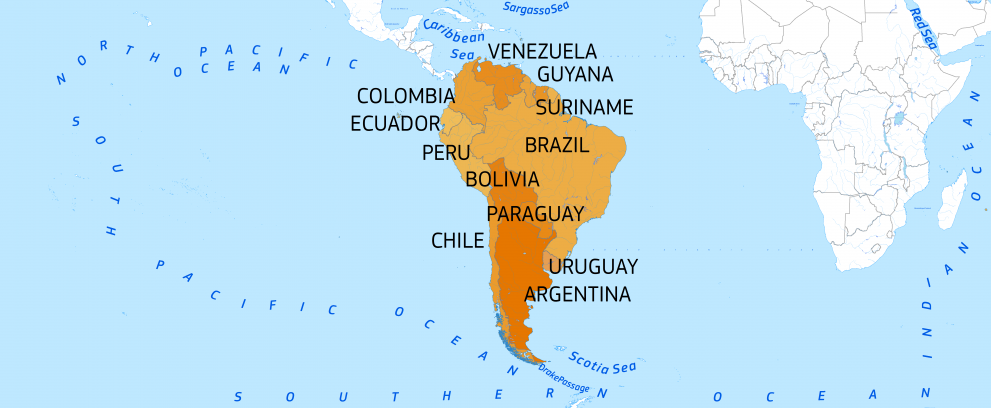Introduction
South America is exposed to multiple, often combined, natural hazards. Climate change has increased the frequency and intensity of weather-related disasters, hampering the resilience of the most vulnerable communities.
The region is also confronted with one of the largest population displacements in its history: more than 6.1 million Venezuelans have sought refuge in neighbouring countries (of which almost 2.5 million are in Colombia, around 1.5 million in Peru, 500,000 in Ecuador, and over 440,000 each in Chile and Brazil).
What are the needs?
The socio-economic crisis in Venezuela has generated an exodus of over 7.3 million people. In addition, an increase in violence and social unrest in several countries in the region is resulting in new mixed migration flows.
Refugees and migrants are exposed to protection risks and have overstretched local public services and the capacity of host communities.
Latin America has also been one of the epicentres of the COVID-19 pandemic, with staggering numbers of infections and deaths. Particularly hit were indigenous communities in remote areas, traditionally among the most vulnerable, due to limited access to basic services and poor sanitary conditions.
Local facilities and infrastructure have become quickly overwhelmed, particularly in Venezuela, the Amazonian borders of Colombia, Peru, Brazil, and the Pacific coast of Colombia.
Besides the spread of COVID-19, the consequences of climate change and the unpredictability of weather-related events also harm the most vulnerable populations.
When disasters strike, the greatest needs are (i) shelter, (ii) food and relief items, (iii) access to safe water and proper sanitation, and (iv) primary healthcare.
Helping affected populations recover their livelihoods is also essential. After emergencies, we also prioritise the protection needs of the most vulnerable groups.

How are we helping?
Since 2016, the EU has allocated €390 million in humanitarian assistance to vulnerable Venezuelans in and outside the country, as well as to host communities. This helps fund emergency healthcare, food assistance, and protection, as well as local capacity building.
This support also helped with the response to the COVID-19 pandemic. In 2021, the EU mobilised €43.5 million in response to the emergency, including €14.5 million allocated for Ecuador, Peru, Colombia, Argentina, Bolivia, Paraguay, and Brazil and the redirection of resources from more than 60 projects.
All EU-funded humanitarian projects aim to guarantee access to water, conduct awareness campaigns, distribute hygiene kits, and provide medical care, among other actions. We pay particular attention to the impact of the pandemic on the indigenous populations in the region.
In addition, as part of the EU global response to COVID-19, a Humanitarian Air Bridge operation consisting of 3 flights delivered life-saving material to Peru in 2020.
Since 1994, the EU has allocated €132.3 million to disaster preparedness projects in Bolivia, Brazil, Colombia, Ecuador, Paraguay, Peru, and Venezuela. It has also strengthened regional disaster preparedness strategies in South America.
The EU’s annual disaster preparedness funding supports initiatives aimed at strengthening the capacity of local institutions and communities to cope with disasters, violence, and crises.
Indicatively by:
- supporting local disaster response committees in drafting emergency plans;
- setting up early warning systems;
- developing information and education campaigns;
- reinforcing vital infrastructure (shelters, schools, and hospitals);
- protecting livelihoods;
- promoting coordination among those responsible for anticipating or reacting to disasters.
South America has also received immediate support in the aftermath of disasters via the European Union Civil Protection Mechanism. Following the deadly earthquake that hit Ecuador in 2016 and claimed more than 650 lives, the EU coordinated relief efforts and provided €5 million in emergency response aid.
In 2017, 2019, and 2023, the EU also deployed experts and firefighters under the Mechanism to help Chile and Bolivia fight some of the worst forest fires recorded on the continent.
The Mechanism was also activated to address Bolivia’s drought in October 2016, the worst floods in 30 years in Peru during March 2017, and to provide expertise in environmental risks related to oil spills, and dam integrity and stability in Colombia in 2018.
In January 2019, an environmental expert was deployed through the Mechanism to support the Capacity for Disaster Reduction Initiative (CADRI) in Bolivia.
To respond to the severe nutritional crisis affecting the Yanomami indigenous population in Brazil in 2023, the EU has allocated emergency humanitarian funding of €500,000 to address their most urgent needs.
Last updated: 14/07/2023

